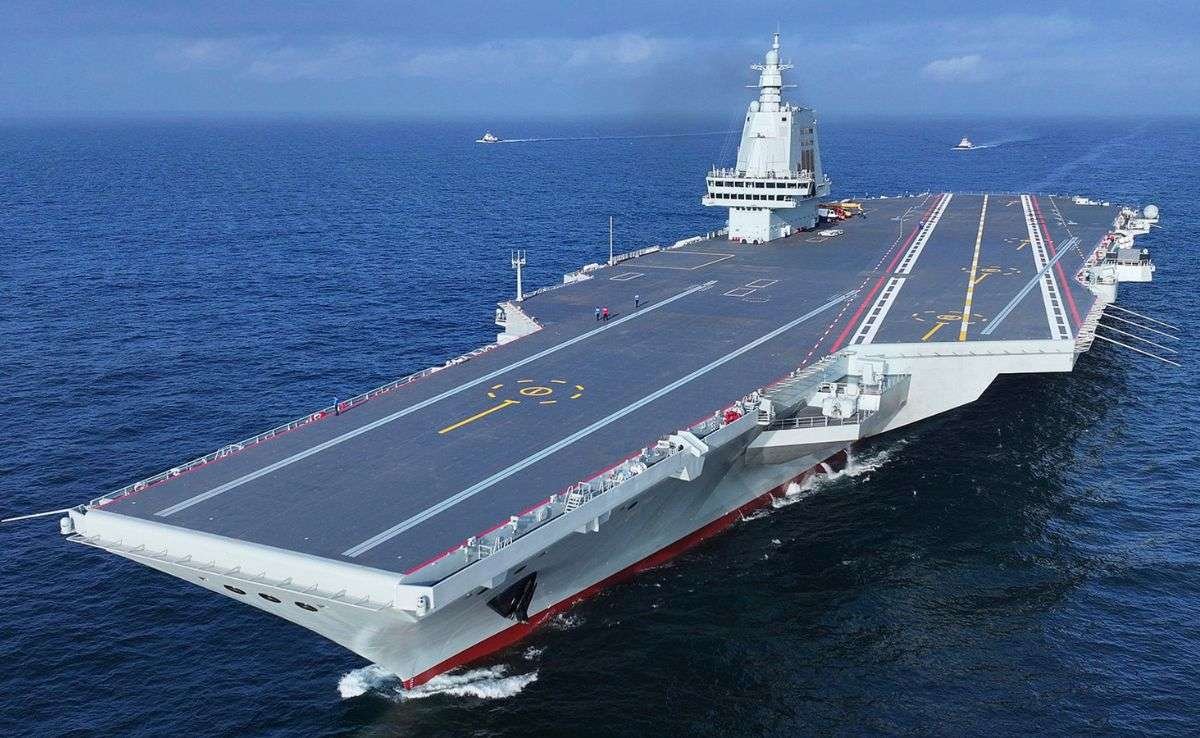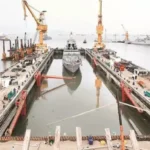- Chinese third Aircraft Carrier, Fujian is undergoing sea trials and expected to be operational around 2026.
- Unlike previous carriers Liaoning and Shandong (refurbished Soviet models), Fujian is a completely indigenous design, showcasing China’s domestic shipbuilding capabilities.
- With a displacement exceeding 80,000 tons, Fujian offers superior capacity for carrying more aircraft, crew and supplies than its predecessors.
- In the last two years, Fujian had already completed its mooring trials, outfitting work, equipment calibrations, and catapult test.
- China’s aircraft carrier fleet will be the second largest in the world after the USA.
China’s naval modernization efforts have included a long-standing focus on acquiring and developing aircraft carrier capabilities, dating back to the 1970s. Since 1985, China has acquired four retired aircraft carriers for study; namely, the British-built Australian HMAS Melbourne and the ex-Soviet carriers Minsk, Kiev and Varyag.
Chinese Aircraft Carrier Programme started with the acquisition of the British-built Australian Navy Aircraft carrier HMAS Melbourne.
In 1985, the People’s Liberation Army Navy (PLAN) acquired the decommissioned Australian aircraft carrier HMAS Melbourne. Before handing over the ship to China, the RAN removed all electronic equipment and weapons and welded her rudders into a fixed position so she could not be reactivated. However, her steam catapult, arresting equipment, and mirror landing system were not removed. This unexpected windfall provided a valuable platform for PLAN engineers.
The PLAN removed the ship’s flight deck and all the equipment associated with flying operations and was studied in depth. Some reports suggest that either a replica of the flight deck or the deck itself, was used for training People’s Liberation Army Navy pilots in carrier flight operations.
Most significantly, PLAN engineers reverse-engineered the launch and recovery systems. A land-based replica was constructed, facilitating successful J-8IIG fighter jet takeoff and landing trials in 1987, which was later confirmed in 2014. This crucial knowledge directly contributed to the development of China’s own carrier-based aircraft, the Shenyang J-15. The acquisition of HMAS Melbourne, initially destined for scrap, proved to be a strategic boon, accelerating China’s naval aviation development. Furthermore, to cultivate the necessary leadership, the PLAN initiated a program in 1987 to train jet fighter pilots as future carrier captains, highlighting their long-term commitment to this domain.
Other Acquisition Attempts
In the 1990s, China pursued multiple avenues to gain aircraft carrier expertise. They negotiated with Spain for carrier designs, acquired decommissioned Soviet carriers for (unofficial) study, and attempted to buy a retired French carrier. While not obtaining a complete blueprint or operational carrier, these efforts show China’s strategic plan to build its own carrier program.
Liaoning (Type 001)
In 1998, China purchased the 67,500-ton ex-Soviet aircraft carrier Varyag (Kuznetsov class) through a private Macau tourist venture, which was only 68% completed and floating in Ukraine. In 2007 there were news reports that Varyag was being fitted out to enter into service. In 2011, People’s Liberation Army Chief of the General Staff Chen Bingde confirmed that China was constructing one aircraft carrier. On 10 August 2011, it was announced that the refurbishment of Varyag was completed and it was undergoing sea trials.
In September 2012, Varyag was commissioned and named Liaoning after the Liaoning Province of China. On 23 September 2012, Liaoning was handed over to the People’s Liberation Army Navy. In November 2012, the first landing was successfully conducted on Liaoning with Shenyang J-15. Four years later, in November 2016, it was reported that Liaoning was combat-ready. China has confirmed that it is constructing a second carrier that will be built entirely with indigenous Chinese designs. Similar to Liaoning, China’s second carrier will also use a ski jump for take-off.
Shandong (Type 002)
Shandong is China’s first domestically produced aircraft carrier. Construction began in November 2013 at the Dalian Shipyard and the ship was launched on 26 April 2017. After being fitted out, the aircraft carrier underwent nine sea trials over 18 months, starting from May 2018. The ship was formally commissioned into service on 19 December 2019 as the Shandong, with pennant number “17”. Shandong is a conventionally powered ski jump carrier with a displacement of around 70,000 tonnes. The ship is derived from the Liaoning. It uses conventional steam turbines with diesel generators as propulsion. The Shandong is a significant improvement over the Soviet-built Liaoning.
Fujian (Type 003)
The Fujian is China’s most advanced aircraft carrier. The construction started in February 2017. On June 17, 2022, Fujian was officially launched with the pennant number “18”. It is the first domestically built aircraft carrier equipped with electromagnetic catapults and arresting devices. It is an entirely different design than Liaoning and Shandong. It is the largest of China’s current fleet. It has a displacement of over 80,000 tonnes and is slightly smaller in size than the US Navy’s Ford Class ships. According to reports, Fujian is approximately 316 meters long and she could carry 50 – 60 aircrafts. The carrier is planned to operate J-15 and J-31 5th-generation fighter aircrafts, Xian KJ 600 airborne early warning and control aircraft, anti-submarine warfare aircraft, and stealth attack drones.
The People’s Liberation Army Navy (PLAN) is actively engaged in the construction of its fourth aircraft carrier, designated Type 004. Construction reportedly started in December 2017 at Jiangnan Shipyard. It will be a 1,10,0000-ton nuclear-powered supercarrier with an integrated electric system that will allow the operation of electromagnetic catapults, and support laser weapons and rail guns. The development of two prototype molten salt nuclear reactors is under progress and it will cost around $3.3 billion.
China’s rapidly expanding carrier fleet signifies its growing ability to project power at greater distances and establish a more geographically dispersed air component. As of today, the PLAN has two active aircraft carriers and the third aircraft carrier is undergoing sea trials. Projections suggest a fleet of five to six carriers by the 2030s. This expansion aligns with China’s blue-water navy aspirations. The Pentagon’s 2023 China Military Power report said that PLAN had about 370 warships. The fleet is expected to grow to 395 ships by 2025 and 435 ships by 2030. The People’s Republic of China (PRC) has embarked on a strategic journey to develop a robust blue-water navy. China’s ambition for a blue-water navy has two main drivers: global influence and economic security.









